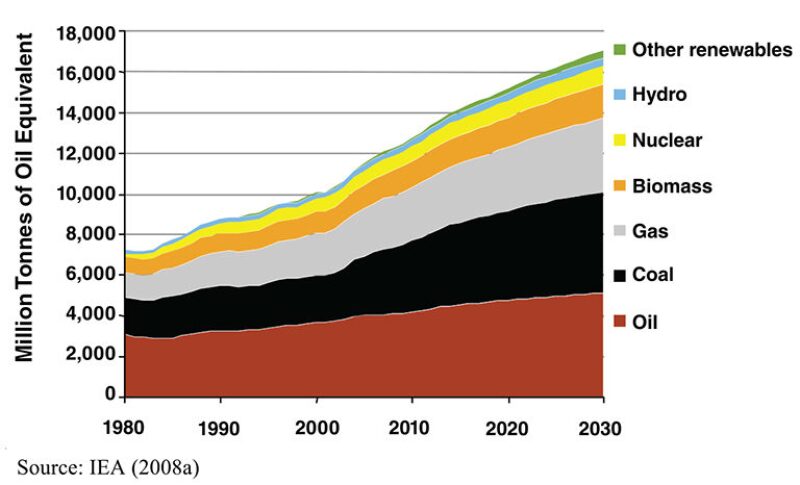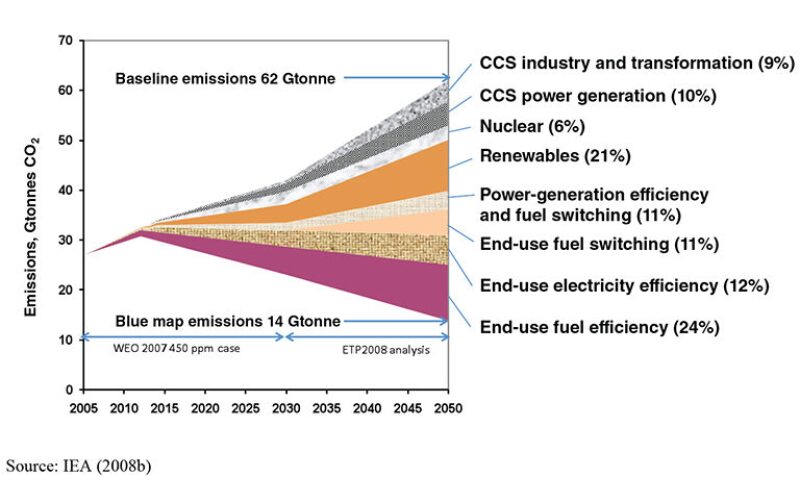This article focuses on the different scenarios for world energy demand and supply, along with their implications on energy-related CO2 emissions. If energy policies do not change significantly (the reference scenario), energy demand will increase significantly over the next two decades, and, because of the fossil fuels in the supply energy mix, greenhouse-gas emissions are projected to increase at alarming levels. The article presents alternative scenarios to lower the emissions, while providing supply security.
The growth in energy use depends on many variables, and principally on growth in population and gross domestic product (GDP). Fig. 1 show the evolution and forecast of the energy mix between 1980 and 2030. With a larger share of the world population having access to energy (electricity, transport, etc.), world energy demand expands by 45% between now and 2030, corresponding to an average rate of increase of 1.6% per year. Coal accounts for more than a third of the overall rise in the next 2 decades. Use of coal had already increased by an average 4.8% annual rate over the last 30 years, compared with 2.6 and 1.6% for gas and oil, respectively. China, India, and the Middle East will account for nearly 80% of oil-demand growth from 2007 to 2030. The investments required in the same time period to sustain such a level of increase in energy use amount to USD 26 trillion, split between the power sector (generation, transmission, and distribution)—52%, the oil sector—24%, and the gas sector—21%.

Is This Scenario Sustainable?
The energy-related CO2 emissions (76% of total CO2 emissions and 61% of global greenhouse emissions in 2006) will increase from 17 Gtonnes in 1980 to more than 40 Gtonnes by 2030 in the reference scenario. A major part of the emissions increase is from countries not part of the Organization for Economic Cooperation and Development (OECD) and is associated with coal. Emissions from fossil-fuel power plants amounted to 11.4 Gtonnes of CO2 in 2006 (41% of the world total). They are projected to increase to 18 Gtonnes in 2030, 45% of the total! Transport is a distant second for emission generation. Coal-fired power plants are the main emission sources, representing nearly three-quarters of total power-sector emissions, and these sources are mainly in China and India.
Power plants built today are likely to be in operation for the next 40 to 60 years. The 2050 outlook given in the IEA publication Energy Technology Perspectives shows an increase of energy-related CO2 emissions that rise to 62 Gtonnes per year. The 2007 Intergovernmental Panel on Climate Change (IPCC) Fourth Assessment Report gives ranges of probable temperature increases related to greenhouse-gas emissions. While a stabilization of emissions in 2050 at current levels would lead to an average 3–4°C increase, the forecast emissions of 62 Gtonnes would lead to an average 4–7°C increase! A 50% reduction in emissions in 2050 (compared with current levels) still leads to a 2–3°C increase.
How Could We Reverse the Trends?
An energy revolution is required, combining a more efficient use of energy in the residential, transportation, and industrial sectors with lower-emission (decarbonized) energy sources. Options in the power-generation sector include renewables, increased efficiency, switching from coal to gas, CO2 capture and storage (CCS), and nuclear energy. Fig. 2 shows the potential impact of a major change in the energy portfolio under the IEA’s “BLUE” scenario, which aims at a 50% reduction in CO2 emissions by 2050. The top curve represents the emissions in the “business as usual” scenario. Getting to the lower curve requires a combination of energy efficiency (the largest component, with 36% of the emission reduction), renewables (21%), CCS (19%), and other measures. In addition to changes in energy-consumptions patterns, achieving this improvement requires increased support of R&D technologies and deployment of energy technologies whose costs can be reduced through learning by doing.

New policies with CO2-reduction incentives to encourage the adoption of low-carbon technologies should be adopted and implemented. Raising public awareness and engaging all stakeholders will be critical for the success of this energy revolution. The challenge is global; it requires the involvement of OECD economies as well as emerging economies.
How Much Will This Cost?
The costs can be given in terms of marginal abatement of CO2 (or greenhouse-gas emissions). The energy portfolio requires a combination of measures with negative marginal cost (end-use efficiency) and positive marginal cost. A significant portion of the curve corresponds to the power sector. CCS in power generation would be triggered by emission-reduction incentives equivalent to USD 50–75 per tonne of CO2. The latter cost translates into an increased cost of electricity production of USD 0.03 to 0.045 per kW-hr for a coal-fired power plant.
Engaging the Industry in the Energy Revolution
Worldwide, only four large-scale CCS projects (i.e., above 1 million tonnes CO2 injected per year) are currently in operation. A massive effort is needed to increase this activity by three orders of magnitude by 2050. Requirements for large-scale deployment of CCS include:
- Increased public awareness about the technology
- Financial mechanisms to offset additional cost for capture and storage
- International cooperation
- Technological developments to reduce costs, especially with capture
- International and national legal and regulatory frameworks
- Creation of a CO2 transport infrastructure (pipelines, shipping)
The oil and gas industry, with the community knowledge of subsurface sciences, can effectively support the ongoing efforts to demonstrate that with the appropriate level of site assessment, wellbore isolation, and monitoring and verification, CO2 injected will remain contained for long periods of time within the formation layers that had been targeted. That would provide increased levels of assurance for the public that any hazards associated with CO2 transport and storage can be mitigated effectively.
Opportunities for Young Professionals (YPs)
If the projected level of activity in CCS materializes, requirements for geoscientists, who will conduct the subsurface assessment and monitoring, will increase significantly. This will create opportunities for today’s and tomorrow’s YPs to engage effectively in the development of a sustainable energy future. In addition to the financial mechanisms for carbon abatement, one of the other main requirements for CCS deployment is increased public awareness and acceptance. YPs can play a major role in the dialogue between stakeholders (including nongovernmental organizations and the educational sector) to highlight the potential of CCS and provide an informed technical contribution to the discussion about long-term storage concerns.
References
IEA. 2008a. World Energy Outlook 2008. Paris: IEA/OECD.
IEA. 2008b. Energy Technology Perspectives: Scenarios and Strategies to 2050. Paris: IEA/OECD.
IPCC. 2007. Climate Change 2007: Mitigation to Climate Change: Contribution of Working Group III to the Fourth Assessment Report of the Intergovernmental Panel on Climate Change, eds. B. Metz, et al. Cambridge, UK and New York, USA: Cambridge University Press.

Active in SPE since 1985, Bennaceur has coauthored five books and more than 100 technical papers, including 20 SPE papers. He has been on the organizing committee of several SPE Forums and Applied Technology Workshops (ATWs), including the North America (Forum) Series, which he cochaired in 2004 and chaired in 2006. Bennaceur served as an ATW committee member during 2003–07 and has been keynote speaker at several SPE events. In 2006, he was selected an SPE Distinguished Member, and in 2007 was named chairman of the SPE CCS committee. Bennaceur is a graduate of the École Polytechnique (Paris) and École Normale Supérieure—Ulm (Paris) and has received the Agrégation de Mathématiques from the Université de Paris.


